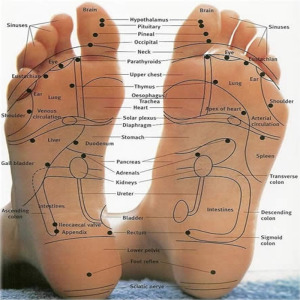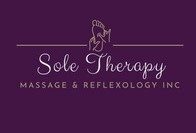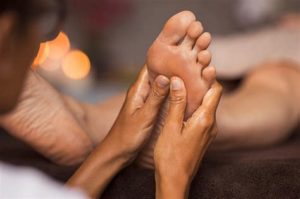Reflexology is one of the many alternative therapies designed to help bring balance to your entire system as a whole. It is a non-invasive method that requires the application of medium-to-firm thumb pressure to specific areas of the feet. Stimulating the appropriate region is intended to eliminate energy blockages thought to produce pain or disease in the related areas.
There are several theories as to why reflexology works, but the most common sense approach is that reflexology is an amazing way to relieve stress and calm those aching feet while maximizing overall health!

As you can see above, the top of the big toes represent the brain and the ball of the foot represents the lungs. Through the application of pressure on particular areas of the hands or feet, reflexology is said to promote benefits such as the relaxation of tension, improvement of circulation, and support of normalized function in the related area in the body.
Throughout history, reflexology has been a health practice in many different cultures around the world. Archeological evidence indicates ancient reflexology systems in China, Egypt, and Japan.
Reflexology was introduced to the United States in 1913 by William H. Fitzgerald M.D. and Dr. Edwin Bowers. Fitzgerald claimed that applying pressure had an anesthetic effect on other areas of the body.
In the 1930s and 1940s, reflexology was changed and updated by Eunice D. Ingham. Ingham was a nurse and physiotherapist. Ingham claimed that the feet and hands were especially sensitive, and mapped the entire body into “reflexes” on the feet. Many of today’s reflexologists use Ingham’s methods.
Treatment Day
A Reflexology session can last anywhere from 30-60 minutes. During your treatment you will be asked a number of questions to determine your present condition. The client sits in a reclining chair or massage table positioning their feet for the reflexologist to work. Finger and thumb pressure, as well as stretch and movement techniques are applied to the entire foot and up to the knee. The application of pressure will be firm in some areas but will remain well within your comfort level.
Each individual has a unique response to a reflexology session- some my feel tired or relaxed while others may energized. It is not uncommon to go through several stages of emotions and body sensations during a session and over the next few days.
If you are interested in learning more, contact me today by using the CONTACT FORM here on the site or by calling (904) 314-6058 today!

